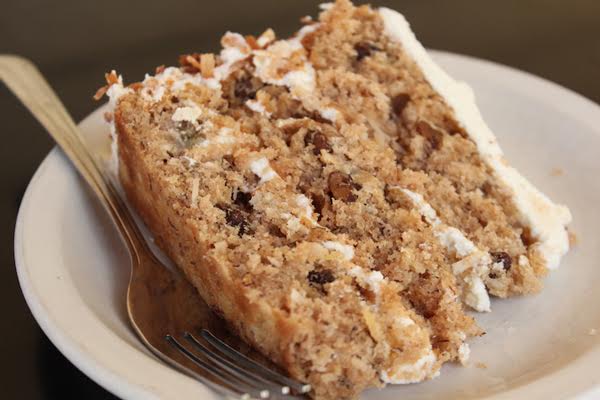A few decades ago, hummingbird cake was the brainchild of a Jamaican marketing exec. Today it’s a beloved American classic, used to celebrate everything from holidays to Tuesdays. It’s the Southern belle of fruitcakes: sweet, a bit sassy, pretty, popular with everyone from brides to grannies.
Once upon a time, about fifty years ago, a new airline was started in Jamaica.
They wanted to get more foreign tourists to visit Jamaica, so naturally they cooked up an advertising campaign that included posters of scantily clad women on white sandy beaches. However, they also sent out recipes for local dishes, including one for “Doctor Bird Cake,” named after the doctor bird, a hummingbird that’s both the national bird of Jamaica and the emblem on the Air Jamaica logo.
The original doctor bird cake was a bundt cake made with bananas. By the early 1970s, recipes for doctor bird cake—sometimes called by other names like doesn’t last cake, nothing left cake, or hummingbird cake, which was the name that stuck—started showing up in small town newspapers across the American south. The recipes featured “tropical” additions like crushed pineapple, shredded coconut, and pecans (which aren’t tropical at all). In 1978, Southern Living printed a recipe for hummingbird cake: a layer cake made with cream cheese frosting, which became the most requested recipe they ever printed. Ten years after the Jamaican tourism board invented it, hummingbird cake was a southern American classic.
Hummingbird cake has more fruit than flour.
Zingerman’s version has almost half a pound more of banana, pineapple, and coconut than flour. The most important flavor booster comes from using super ripe bananas. The ideal banana for hummingbird cake has a dark yellow peel covered with lots of dark brown splotches. When that happens, the starches in the fruit have all broken down into sugars and it’s at its peak sweetness. The trouble is that no one sells bananas that look like that: groceries discard the too-ripe bananas in order to display the ones that still have green shoulders that customers prefer. To get just the right flavor for the cake, we buy the bananas that groceries would normally toss—and if they’re still not sweet enough, we hold onto them until they reach their peak ripeness. Then it’s all hands on deck to get them all peeled and frozen.
Hummingbird cake is also unique in that it’s traditionally made with oil, not butter. Using oil gives the cake a super moist and light texture. Even if you were to eat a slice right from the refrigerator (an act I don’t recommend because it’ll be way more flavorful at room temperature, but hey, I get it—sometimes you can’t wait to have your cake and eat it too) it will still be the moistest cake you ever ate.
One final flavor booster is the toasted pecans that are mixed into the dough. Like saving bananas until they’re fully ripe, toasting the nuts is a step that takes extra time but pays huge dividends in flavor. We toast the all the nuts we bake with, for everything from coffeecakes to breads. The toasted nuts are sweet and roasty with a great depth of flavor. We also toast a bit of coconut that gets sprinkled on the rich vanilla butter cream frosting on the sides of the cake.
Hummingbird cake is a big favorite for weddings around Ann Arbor.
“After they taste it, brides always end up choosing to have hummingbird cakes for their weddings,” explained Amy Emberling, pastry maven and co-owner at Zingerman’s Bakehouse. It’s a show-stopping centerpiece for just about any event. My co-worker Angela uses the hummingbird cake as her go-to for just about every occasion: her birthday, apologies, anniversaries, Mother’s Day. And at Zingerman’s Roadhouse, it’s been one of the most popular choices on the dessert menu since day one.

